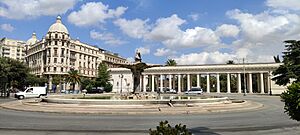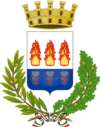Foggia facts for kids
Quick facts for kids
Foggia
Fògge (Neapolitan)
|
|||
|---|---|---|---|
| Comune di Foggia | |||

Piazza Cavour in Foggia
|
|||
|
|||

Foggia within the Province of Foggia
|
|||
| Country | Italy | ||
| Region | |||
| Province | Foggia (FG) | ||
| Frazioni | Arpinova, Incoronata, Cervaro, Tavernola, Segezia, Duanera La Rocca | ||
| Area | |||
| • Total | 507 km2 (196 sq mi) | ||
| Elevation | 76 m (249 ft) | ||
| Population
(31/12/2013)
|
|||
| • Total | 153,143 | ||
| • Density | 302.06/km2 (782.3/sq mi) | ||
| Demonym(s) | Foggians | ||
| Time zone | UTC+1 (CET) | ||
| • Summer (DST) | UTC+2 (CEST) | ||
| Postal code |
71121 - 71122 - 71100
|
||
| Dialing code | 0881 | ||
| Patron saint | Madonna dei Sette Veli | ||
| Saint day | March 22 | ||
Foggia is a city and a comune (municipality) in the Apulia region of Southern Italy. It is the capital of the province of Foggia. In 2013, about 153,143 people lived there. Foggia is the main city of a large flat area called Tavoliere. This area is often called the "granary of Italy" because it produces a lot of wheat.
Contents
History of Foggia
The name "Foggia" likely comes from the Latin word "fovea", which means "pit". This might refer to pits used to store wheat. Another idea is that it comes from the Greek word "fotia", meaning "fire". Legend says that early settlers found a picture of the Madonna with three flames burning on it.
People have lived in this area since the Neolithic Age (New Stone Age). An ancient settlement called Arpi was also nearby.
The first official mention of the modern city was in 1100. Back then, the area was marshy and unhealthy. In the late 11th century, Robert Guiscard helped drain the wetlands. This helped the city grow economically and socially.
In the 12th century, William II of Sicily built a beautiful cathedral in Foggia. He also made the settlement bigger.
Foggia in the Middle Ages
Frederick II built a palace in Foggia in 1223. He loved the city and often stayed there. He even called it "Regalis Sedes Inclita Imperialis," meaning "Royal and Famous Imperial Seat." It was also a center for learning.
In 1447, King Alfonso V of Aragon built a Custom Palace. This palace collected taxes from local sheep farmers. This tax system unfortunately hurt the local economy. It also caused the land to become marshy again.
Foggia was hit by several earthquakes over the centuries. A big one in 1731 destroyed a third of the city. After this, the House of Bourbon helped rebuild Foggia. They also encouraged growing cereals, which helped the economy.
Modern Foggia
In the 19th century, Foggia got a railway station. Many public buildings were also built. Citizens of Foggia helped in the movements that led to Italy becoming a united country in 1861. By 1865, farming became more important than sheep herding.
A big problem for Foggia was the lack of water. This was solved in 1924 with the building of the Apulian aqueduct. By then, Foggia was already an important connection point between northern and southern Italy.
During World War II, Foggia was heavily bombed by Allied forces. This was because it had important airfields and railway yards. On July 22, 1943, over 100 B-17 Flying Fortresses bombed the city. This caused huge damage and many people were killed. Another major bombing on August 19, 1943, caused even more destruction.
After Italy signed an armistice (peace agreement) in September 1943, German troops briefly occupied Foggia. British troops successfully took over the city on October 1, 1943. The airfields were then used by Allied planes until the end of the war.
In 1959 and 2006, Foggia received special gold medals. These medals honored its bravery and importance during World War II.
Geography and Climate
Foggia has a Mediterranean climate. This means it has dry summers.
- Winter days are usually between 11 and 13 °C (52-55 °F). Temperatures can sometimes drop to single digits. Freezing temperatures happen a few times a year.
- Summers are very hot. In July and August, temperatures often reach 33-38 °C (91-100 °F). Temperatures can even go above 40 °C (104 °F) sometimes.
- The lowest temperature ever recorded was -10.4 °C (13.3 °F) in January 1985.
- The highest temperature ever recorded was 47 °C (117 °F) in June 2007. This is one of the highest temperatures ever recorded in Europe!
| Climate data for Foggia ITA, 1981–2010, Extremes 1980- | |||||||||||||
|---|---|---|---|---|---|---|---|---|---|---|---|---|---|
| Month | Jan | Feb | Mar | Apr | May | Jun | Jul | Aug | Sep | Oct | Nov | Dec | Year |
| Record high °C (°F) | 21.2 (70.2) |
22.0 (71.6) |
32.0 (89.6) |
30.3 (86.5) |
36.0 (96.8) |
47.0 (116.6) |
45.2 (113.4) |
43.6 (110.5) |
43.0 (109.4) |
35.4 (95.7) |
27.0 (80.6) |
23.4 (74.1) |
47.0 (116.6) |
| Mean maximum °C (°F) | 17.9 (64.2) |
18.5 (65.3) |
22.6 (72.7) |
25.1 (77.2) |
30.9 (87.6) |
36.3 (97.3) |
39.1 (102.4) |
38.5 (101.3) |
34.0 (93.2) |
29.3 (84.7) |
22.8 (73.0) |
18.9 (66.0) |
40.3 (104.5) |
| Mean daily maximum °C (°F) | 11.8 (53.2) |
12.5 (54.5) |
15.7 (60.3) |
19.0 (66.2) |
24.9 (76.8) |
29.4 (84.9) |
32.4 (90.3) |
32.5 (90.5) |
27.6 (81.7) |
22.7 (72.9) |
16.6 (61.9) |
12.7 (54.9) |
21.5 (70.7) |
| Daily mean °C (°F) | 7.7 (45.9) |
7.7 (45.9) |
10.3 (50.5) |
13.1 (55.6) |
18.3 (64.9) |
22.6 (72.7) |
25.6 (78.1) |
25.8 (78.4) |
21.5 (70.7) |
17.3 (63.1) |
12.1 (53.8) |
8.7 (47.7) |
15.9 (60.6) |
| Mean daily minimum °C (°F) | 3.3 (37.9) |
2.9 (37.2) |
4.9 (40.8) |
7.3 (45.1) |
11.7 (53.1) |
15.9 (60.6) |
18.8 (65.8) |
19.0 (66.2) |
15.5 (59.9) |
12.0 (53.6) |
7.6 (45.7) |
4.7 (40.5) |
10.3 (50.5) |
| Mean minimum °C (°F) | −3.0 (26.6) |
−2.6 (27.3) |
−1.1 (30.0) |
1.1 (34.0) |
5.8 (42.4) |
9.9 (49.8) |
13.1 (55.6) |
14.2 (57.6) |
10.4 (50.7) |
4.8 (40.6) |
0.7 (33.3) |
−1.7 (28.9) |
−4.4 (24.1) |
| Record low °C (°F) | −10.4 (13.3) |
−6.0 (21.2) |
−5.0 (23.0) |
−4.0 (24.8) |
0.3 (32.5) |
2.8 (37.0) |
6.0 (42.8) |
10.0 (50.0) |
6.4 (43.5) |
0.0 (32.0) |
−2.8 (27.0) |
−5.0 (23.0) |
−10.4 (13.3) |
| Average rainfall mm (inches) | 44.60 (1.76) |
39.37 (1.55) |
41.73 (1.64) |
39.01 (1.54) |
31.52 (1.24) |
42.46 (1.67) |
21.65 (0.85) |
39.82 (1.57) |
43.15 (1.70) |
50.39 (1.98) |
48.98 (1.93) |
69.34 (2.73) |
512.03 (20.16) |
| Average relative humidity (%) | 82.1 | 77.7 | 75.5 | 73.4 | 67.7 | 61.7 | 58.1 | 61.1 | 69.7 | 76.2 | 81.6 | 82.7 | 72.3 |
| Source: Il Meteo | |||||||||||||
Main Sights to See
Foggia has many interesting places to visit:
- Foggia Cathedral: This church, Santa Maria de Fovea, was built around 1179. It is connected to the city's patron saint, "Madonna dei Sette Veli" (Madonna of the Seven Veils). The lower part of the cathedral is in the old Romanesque style. The upper part is a beautiful example of Baroque style. It was rebuilt after an earthquake in 1731.
- Palazzo Dogana: This historic palace was once where taxes were collected from sheep farmers. In 2013, UNESCO named it a "Messenger Monument of the Culture of Peace." This was because of its important role in cultural exchanges over many centuries.
- Chiesa delle Croci ("Church of the Crosses").
- I Tre Archi ("The Three Arches").
- Arco di Federico II ("Arch of Frederick II").
- Archaeological park of Passo di Corvo: An ancient site where you can learn about the past.
Economy of Foggia
Foggia is an important center for transport and industry. It is also the main market for wheat in Southern Italy. The city is well-known for its delicious watermelons and tomatoes.
Farming is still the most important part of Foggia's economy. The area is even called the "granary of Italy" because of all the grain it produces. There are also some industries that process food. Local crafts and handmade goods are also important and growing.
Transportation
Foggia has a busy Foggia railway station, which opened in 1864. It is part of the main Adriatic Railway line that connects Ancona to Lecce. It is also the end point for the Naples–Foggia railway. Many other smaller railway lines also connect here. This makes Foggia a very important railway hub in southern Italy.
The city is also served by Gino Lisa Airport. This airport offers direct helicopter flights to the ITremiti Islands and Vieste.
Sports in Foggia
Foggia is home to the football (soccer) club Calcio Foggia 1920 S.S.D.. They play in Serie C, which is the third division of football in Italy. In the early 1990s, the club became famous for its exciting style of play called "Total Football". This led them to play in Serie A, Italy's top football league, for a short time. The team plays at Stadio Pino Zaccheria. This stadium is named after Pino Zaccheria, a local basketball pioneer who died during World War II.
In February 2019, Foggia hosted the European Cadet and Junior Fencing Championships. This was a big event for young fencers from all over Europe.
Famous People from Foggia
Many notable people come from Foggia:
- Renzo Arbore (born 1937), a television showman and musician.
- Alex Baroni (1966–2002), a singer.
- Adriano Celentano (born 1938), a singer, actor, and television showman.
- Donato Coco (born 1956), an automobile designer who was chief designer at Ferrari.
- Mauro De Mauro (1921–1970), a journalist.
- Luigi Samele (born 1987), an Olympic sabre fencer.
- Pietro Giannone (1676–1748), a philosopher.
- Umberto Giordano (1867–1948), a famous composer. There is a town square named after him.
- Vladimir Luxuria (born 1965), an Italian politician.
- Mario Mauro (born 1961), a former minister of defence.
- Andrea Pazienza (1956–1988), a cartoonist.
- Pio e Amedeo (born 1983), actors and producers.
- Michele Placido (born 1946), an actor and director.
- Nicola Sacco (1891–1927), an anarchist.
- Vincent Simone (born 1979), a dancer.
- Tony Slydini (1900–1991), a magician.
- Nicola Zingarelli (1860–1935), a language expert.
Sister Cities
Foggia is twinned with several cities around the world. This means they have special friendly relationships and often share culture and ideas.
Images for kids
See also
 In Spanish: Foggia para niños
In Spanish: Foggia para niños






